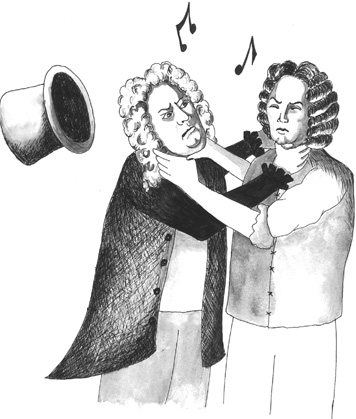
TWEEDLEDUM and Tweedledee
Agreed to have a battle;
For Tweedledum said Tweedledee
Had spoiled his nice new rattle.
Just then flew down a monstrous crow,
As black as a tar-barrel;
Which frightened both the heroes so,
They quite forgot their battle.
Tweedledum and Tweedledee found fame as fictional characters in Lewis Carroll’s Through the Looking-Glass, and What Alice Found There, published in 1871. Carroll describes the two as a pair of tubby brothers whom Alice comes across on her travels and who put her in mind of ‘the old song’, which the brothers later act out. Carroll’s illustrator, John Tenniel (see also Humpty Dumpty and The Queen of Hearts), depicted the ‘fat little men’ as identical twins, ‘like a couple of great schoolboys’, completely indistinguishable from each other. And that is why the expression Tweedledum and Tweedledee is used to this day to describe any two persons or objects that are so alike they cannot be identified individually.
But he didn’t invent them. They were figures from a nursery rhyme Carroll would have heard as a child. The original Tweedledum and Tweedledee made their first appearance at least a century earlier, in a poem published in 1725 making fun of two feuding composers, Giovanni Battista Bononcini (1670-1747) and George Frideric Handel (1685-1759).
Handel and Bononcini had a long history. In Berlin in 1696, the young Handel was recognized as a child prodigy. At the royal court he met an established Italian composer, Bononcini. The older composer was instantly jealous of the young newcomer and attempted to injure his reputation by composing a particularly testing piece for the harpsichord and then asking him to play it at sight. When Handel executed it without a mistake, the schemer was foiled by his own device and duly hated the younger man all the more for it.
Twenty-four years later, in London, a number of noblemen formed themselves into a company for the purpose of reviving Italian opera in England. The king himself, George I, subscribed £1,000, and allowed the society to take the name of the Royal Academy of Music. Handel was appointed Director of Music.
Bononcini and Attilio Ariosti were attracted to London by this new venture, and stage two of the rivalry followed. The composition of a new opera, Muzio Scevola, was divided between the three composers. Attilio was to put the first act to music, Bononcini the second, and Handel the third, but a dispute developed between the latter two. Amused by this bout of semiquavers at ten paces, the poet John Byrom wrote:
Some say, compar’d to Bononcini,
That Mynheer Handel’s but a Ninny;
Others aver, that he to Handel
Is scarcely fit to hold a Candle:
Strange all this difference should be
’Twixt Tweedle-dum and Tweedle-dee!
Clearly Byrom is suggesting a small dum here and a tiny dee there are the only real discernible differences in the two composing styles – in which Tweedle-dum and Tweedle-dee sound like a mocking representation of their music – or, at least, that is what they were arguing over. Handel was extremely put out by this – he didn’t want to be identified as part of a matching pair with his nemesis – and so, when the opportunity to get rid of Bononcini arose, he grabbed it…
This all came courtesy of another composer and former friend of Handel, Maurice Greene (1676-1755). A gifted composer in his own right, Greene had once been close to Handel but they had fallen out when the latter found Greene was also friends with Bononcini. As a result, Greene’s friendship with Bononcini became even closer; indeed, in 1728 Bononcini fashioned the madrigal ‘In Una Siepe Ombrosa’ (‘In a Shady Hedge’), attributing the piece to his new friend in an attempt to help raise his profile. Unfortunately, another composer, Antonio Lotti, then complained he had written the music thirty years earlier and was able to produce eight separate witnesses who were prepared to confirm they had heard Lotti play the piece in rehearsal. Bononcini was thrown out of the Academy in disgrace, Handel pouring scorn on him in public at every opportunity, and eventually driven from London. Despite

never having signed the work, or so much as even claiming authorship, Bononcini’s reputation hung in tatters and he’s now barely remembered. He died alone in 1747 somewhere near Vienna.